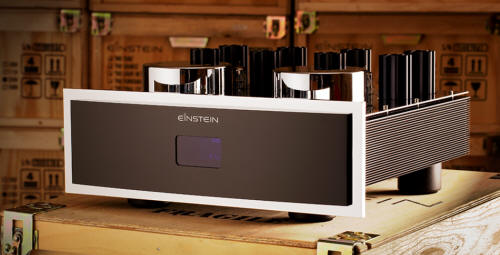|
|
You are reading the older HTML site
Positive Feedback ISSUE 72
einstein The Poweramp as reviewed by Danny Kaey
For me there are two, possibly three types of audio, nay, high-end audio companies: there are your traditional, single focus minded guys and gals who come out with a product now and then, or, really only when it make sense. The temptation to resist what I label "gadgetization", "gadgetizationalitis" must, in 2014, indeed be a difficult one to resist. Imagine Spectral launching a new poweramp every year (at CES). Imagine the outcry. See what I mean? Let's face it: Spectral isn't in business to monetize the latest and greatest feature set every 2-3 months (or even years), after all, this isn't the handset business, otherwise known as Android. Next, you have the guys who are somewhere in between. Let's add a feature here, a sparkle there, maybe add a ¼" of copper to a 'table's platter and voila, we have ourselves a new and improved something-or-another. Think Clear Audio, Transrotor, TW Acustic, etc. The question that invariably rears its head here is, of course, the dreaded (especially for the reviewer who's tasked to objectively form an opinion) "Yes that's great, but is it really better?" Doubtful in any real, significant terms; alas, business is business, and so more power to you for being able to pull that sort of thang off the ground. Clearly this sort of approach works for some; obviously the market accepts it and sales are being generated. The third such audio company is your typical big-box retail focused endeavor (I suppose it's debatable if this category falls into the classical mold that is high-end audio, alas, you get my point). The bigger, the better, grab the microsecond attention span of your traditional Best Buy customer and go for the gold. Shiny new toys, mostly for boys. Sounds like a solid proposition to me. Get 'em in there, rack 'em, stack 'em. Think Boilerroom for audio. Hey, we've all seen the kind; heck, sometimes you do fall for that, what with all the glitz and glamor, who could resist. EINSTEIN Audio, of course, is no such company—heaven forbid. EINSTEIN is clearly part of the first category: new amp every year? Right. Think again. Heck, EINSTEIN's portfolio has probably been turned no more than twice in the company's 26 year history and that's saying something. Longevity. Reliability. Exclusivity. Here's the way I look at this: if something is designed from the ground up to be right, then really no amount of futzing will change that downstream. And so, only—and that's to be appreciated more than you think or know—when and if better technologies come along does a new product get announced and set free. Such is the case with EINSTEIN's latest amplifier, aptly named The Poweramp. Replacing the previous version, The Light In The Dark Limited Edition (there's a handful!), The Poweramp continues EINSTEIN's tradition of offering up genuinely different and unique technology in an attractive and stylish package. More or less based on the company's celebrated OTL reference mono block amplifiers, The Silver Bullet, The Poweramp continues the tradition of unique amplification design. As Volker Bohlmeier (EINSTEIN's principal) says, "Our goal with The Poweramp was to essentially recreate the topology of our OTL amplifier in a more compact stereo chassis utilzing integrated circuits instead." And recreate their OTL amplifier they did. Utilizing the same strict adherence to a fully balanced design, The Poweramp is in effect two mono amplifiers in a single chassis. Capitalizing on each design's strengths, the input section is built around double triode PCC88 tubes which help produce the extreme linearity The Poweramp is capable of. The output stage uses two identical ICs per channel, which according to Volker, really is the equivalent of the OTLs massive output tubes. Greatly upgraded power supplies compliment the package, thus giving The Poweramp the ability to drive virtually any speaker to maddening ear-bleed levels with the utmost in control, finesse, dynamic range, and speed. Needless to say, Volker is of the persuasion that less power yields dramatically better sound, really claiming that 90W is more than plenty to accommodate most speakers and most rooms without any issues. Practically speaking, The Poweramp simply looks more ballsy in real and absolute terms. The chassis, now cut from a solid block of aluminum, seems substantially beefier (the old one wasn't a slouch either!) while the dramatically larger power supply transformers (one per channel) add to the overall heft of the amplifier. The previous model's power and standby switches are now gone too, replaced by a simple on/off switch as is customary with EINSTEIN underneath the chassis. The omission of the two switches leaves in place the clean, beveled high-gloss black front plate that now looks quite more striking. Cleverly solved gain switching (outside the signal path of course!) is done via plug-in resistors that can be added and removed on the back of the amplifier. All in all, a seemingly substantial upgrade then, worthy of a new product – see category 1. Arriving in EINSTEIN's typical, double-boxed wooden crate, unboxing of The Poweramp becomes an easy, if weighty task. Compared to most other high-end components, even something as mundane as packaging, EINSTEIN manages to stand out from the rest. Nice touch. Given the $27,300 US retail price from EINSTEIN's freshly minted US distributor, the ever affable, clever Irish man otherwise known as Philip O'Hanlon of On A Higher Note, The Poweramp joins an altogether exclusive, supreme club of high price, high performance audio. Certainly compared to the typical cookie-cutter massive jewel box amplifiers of that region, The Poweramp manages to stand out: classy, sassy, and stylish are words that frequently get thrown around when friends and folk come to casa K for a visit. Going from the already damned good The Light In The Dark Limited Edition to this new guy was as easy as unplugging one, replacing it with the other, and turning the power on. Now, speaking of power: EINSTEIN was also kind enough to send along their latest power strip, The Octopus, aptly named for its 8 power outlets. Not really any sort of power "conditioning" unit per se, The Octopus (US $2990) is a really, really, really great power strip, with a few value add twists that are well, let's call it typical EINSTEIN. For starters, the triangulated case is laser cut and laser welded from solid steel. Turns out that a large German industrialist specialty manufacturer in close proximity to Bochum (Germany, EINSTEIN's place of birth), is also an avid Hi-Fi connoisseur and thusly offered plans to manufacture The Octopus in small batches for a price that no other mortal would have been able to get this side of commercial manufacturing sanity. Not merely being satisfied with standard fare power strip stuff, The Octopus utilizes a specially sourced industrial grade 16A power input connector; 4 of the 8 outlets are equipped with an industrial grade RF filter used in high-end RF applications. Surge protection, phase detection, and a nicely made voltage indicator (with cool blue LED display) round out the feature set of this power strip, EINSTEIN style. While in general I have not been a proponent of power filtration / regeneration / etc. systems (other than the Nordost system I am presently using, which goes markedly against the grain of my perception), The Octopus clearly isn't playing for keeps in that field and realm; no, The Octopus (I bet had they called it "Octopussy", the Broccoli family of James Bond 007 fame and fortune would have gone after them like mad…) is your traditional 8 outlet powerstrip with the aforementioned EINSTEIN twist of superior quality, execution and let's not forget, it's, it's supremo-stylish to boot. Alas, more on my sonic impressions with this lil' darlin' later on. Now on those EINSTEIN power ratings: rated—conservatively—at 90W of power on an 8 Ohm load (going up to 140 @ 4) some of my usual DK posse let loose that they feared those numbers to be on the low side for such a reference level amplifier design. While in this day and age, mega-watt, mega-buck amplifiers appear to be the norm (select manufacturers seeking to stay out of the race for obvious reasons), I assure you that under normal conditions, 90W of output power are actually rather sufficient for even the most demanding of listening sessions. Having exposed the previous champ, The Light In The Dark Limited, rated at 80W, to various speaker loads from around 87 to 101 db efficiency, I never once ran out of juice, even though—at times—I cranked the volume to 11. After all, music has to be felt, not merely heard. Provocateur Srajan Ebaen of 6Moons recently opined about this very topic on DAR (the affable opposite, John Darko, whose clever digs I dig) and surmises what most sane people already know: power ain't everything. Alas, take a look for yourself here. My thoughts on the mega-power rat-race are such that I feel it has a certain kinship with the mega-pixel race of year's past: more, more, more somehow equals better. While giving you an apparently far larger canvas from which you can crop yourself to death, you end up obscuring detail, fine color grading and overall appear to add layers of haze and digital schmutz. I think that—in broad audio terms—similar characteristics can be found: again, it is fairly well accepted knowledge that in general lower powered amplifiers do in fact sound better. Going back to even the days of tubes, your typical vintage McIntosh MC30 will in fact sound better than 'tosh's MC75. More amplification = more grit and crud. Who knows, I'm not a circuit designer, merely one who pretends to know what's going on. Thus, within minutes of playing, The Poweramp at 90 felt right at home. These EINSTEIN guys know what they are doing. Cueing up the usual faire of DK specials, this amp sang like a champ. At once, it became evident that the new model, whilst nominally gaining only a handful of Watts in output power, sounded far more powerful overall. Call it stage presence, soundstage, bandwidth, resolution, The Poweramp is a significant upgrade to its brother's sonics. Electronica, say, Kraftwerk, Trentemōller, Bebel Gilberto, etc. all sounded more impactful and exploded with greater power, depth, and overall resolving power. Watts are Watts, at least that's what they say—assuming this to be true, then clearly Volker and company have added to the sonic picture of The Poweramp by ways of cleverly extracting that much more sonic bliss from components found elsewhere. Take for example Dean Martin's latest hi-res reissues, recently remastered by guru Vic Anesini from "the best possible sources," available for download at Chad Kassem's newest digs, SuperHiRez. Dream With Dean, perhaps considered to be his most evocative and stimulating album (though I could name at least a dozen more, the Dino aficionado that I am), was given the royal treatment by Vic. And I do mean royal. Most familiar am I with this album, as three copies of various and dubious quality levels grace my record shelves. To say that I am intimately familiar with this album is to make it an understatement of royally epic proportions. Harrumph, harrumph! (Hey, I didn't get a harrumph out of that guy!) Expertly produced by Jimmy Bowen, this is a closely mic'd, warm and lush sounding release with such legends as Ken Lane (piano), Barney Kessel (guitars), and Red Mitchell (bass), all in tuneful arrangements around Mr. Crooner himself. "Everybody Loves Somebody," originally released as the hit single (which, btw, was in fact the first single to take the Beatles off their No. 1 spot), is completely rearranged and redone in this recording. Trust me on this one; you want to go and grab the download, and the (clean) LP! PS: rumor has it someone somewhere is working on a 45 rpm vinyl and DSD release… Might be Chad himself for all I know. But I digress. A quaint piano, a bit of guitar work there, rarely any bass to speak of, this is in fact the version that should have been the hit single. Following this track via my vinyl vault, when all planets are in proper alignment, read: your stylus, is set at the correct VTA, azimuth, etc., then you'll be in for a treat (provided you, as I, have found a nice and clean copy), as the album's sonics are quite simply spectacular. Dean is projected into your room with proper physical attributes of his voice; the soft piano adding simple touches to the blissful tune that is Dean Martin doing what he does best: crooning. Lesser presentations seem to miss the focus points and overall presentation in favor of a more blasé sounding vocal performance. Switching over to the freshly minted and aforementioned hi-res version, and comparing the Light In The Dark Limited to the new kid on the block, The Poweramp opens up the world of Dean Martin even more. No matter the speaker, Zu's fabulous Druid V (review forthcoming) or Wilson Audio's smashing Alexia (review forthcoming), The Poweramp projected more authority, articulation, and presence to the performance while also cleaning up last bits of hash and miniscule amounts of top-end glare from the previous dude. The tonal balance is decidedly neutral, with no signs of haze or distortion anywhere in the frequency band. Bass (perhaps the clearest indicator of an amp's power rating) is tight, well extended and goes even deeper than its predecessor. Midrange presence is where the new guy shines the most: void from any noise or glare, the amp's resolving power is magical indeed. Don't get me wrong: without having the new kid on hand to directly compare, the former isn't a slouch by any means; its just that the obvious becomes that much more apparent when making the swap. EINSTEIN has, over the years, produced some very fine equipment indeed. Most admirable of them is the fact that unlike so many others, new stuff doesn't just happen all so often: in fact, only when the new product can really outshine the old one and lay the foundation for a next generation. I recall speaking with Volker Bohlmeier about this fact just this last summer, where he casually mentioned that in fact most of their products, going back to the original launches some 26 years ago, are still in circulation being used and listened to by Hi-Fi fans all over the world. Take it for what it's worth: The Poweramp is a stellar performer, worthy of being the crown jewel to any system you pair it up with. Neutral, powerful, with incredible clarity and slam, I'd say this one is a safe bet for even the most discerning of audiophiles. Considering its topology is similar to EINSTEIN's reference, their OTL Silver Bullet amplifier, you simply must give this one a listen. Most highly recommended, A+++. PS: The Octopus power strip is one of those devices that you seemingly could live without, until you actually have one in your system and you realize that you really shouldn't live without it. While in and of itself, the power strip doesn't perform any magic onto the incoming AC signal, it seems to somehow add a certain level of cohesion and refinement to the overall EINSTEIN system. Small as these refinements seem as a whole, you do realize that something is in fact missing from the presentation when The Octopus is taken out of the system. To boot, you have the benefit of, at a glance, being able to spot check phase and the incoming voltage whilst also protecting your entire system from dreaded black- or brown- outs, and it quickly becomes obvious that this is one of those must haves for really any system, EINSTEIN sourced or not. Similar to EINSTEIN's cable line, The Flash and The Thunder, The Octopus performs its task in the quiet: it delivers a bunch of performance that is definitely noticeable and real. Even if all you needed was simply a proper power strip to connect all your Hi-Fi to, this one would be something I'd look into. In this case, like all of EINSTEIN's products, gorgeous looks and stunning build quality go much further than just that. Must have. A+++. Danny Kaey
The Poweramp
The Octopus
EINSTEIN Distributor
Philip O'Hanlon, On A Higher Note
|









